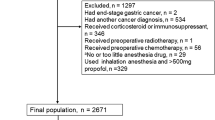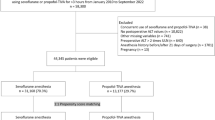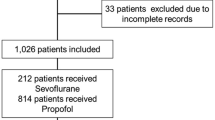Abstract
The incidence of an abnormal increase in the serum levels of glutamic oxaloacetic transaminase (GOT) and glutamic pyruvic transaminase (GPT) following anesthesia with halothane and 65% nitrous oxide in oxygen (halothane group) or with sevoflurane and 65% nitrous oxide in oxygen (sevoflurane group) was compared in women undergoing surgery for breast cancer. An abnormal increase in GOT and GPT, both defined as higher than 50 IU, occurred postoperatively in 2 of the 150 patients (1.7%) in the sevoflurane group, and in 37 of the 200 (18.5%) in the halothane group (P<0.001). The elevated levels of serum transaminases after sevoflurane ranged from 50 to 65 IU whereas those after halothane ranged from 50 to 1000 IU, except for a value greater than 5000 IU in 1 patient. In the halothane group, there was a significant association between postoperative increases in serum transaminases and previous exposure to inhalation anesthetics, postoperative mitomycin therapy, and radiation therapy (all P<0.001). The results of multivariate analysis, when data from all patients were taken together, showed that the type of anesthetic (halothane) was the highest factor related to postoperative increases in GOT and GPT (odds ratio 35.85; 95% confidence interval 5.92–217.37), followed next by prior exposure to inhalation anesthetics (8.65; 2.96–25.27), postoperative radiation therapy (4.37; 1.70–11.19), and postoperative mitomycin therapy (3.56; 1.23–10.35). These data suggest that sevoflurane is less likely to cause anesthesia-related liver dysfunction than halothane.
Similar content being viewed by others
References
Fee JPH, Black GW, Dundee JW, McIlroy PDA, Johnston HML, Johnston SB, Black IHC, McNeill HG, Neill DW, Doggart JR, Merrett JD, McDonald JR, Bradley DSG, Haire M, McMillan SA (1979) A prospective study of liver enzyme and other changes following repeat administration of halothane and enflurane. Br J Anaesth 51:1133–1141
Trowell J, Peto R, Crampton-Smith A (1975) Controlled trial of repeated halothane anaesthesia in patients with carcinoma of the uterine cervix treated with radium. Lancet 1:821–824
Wright R, Eade OE, Chisholm M, Hawksley M, Lloyd B, Moles TM, Edwards JC, Gardner MJ (1975) Controlled prospective study of the effect on liver function of multiple exposures to halothane. Lancet 1:817–820
Allen PJ, Downing JW (1977) A prospective study of hepatocellular function after repeated exposures to halothane or enflurane in women undergoing radium therapy for cervical cancer. Br J Anaesth 49:1035–1039
Allan LG, Hussey AJ, Howie J, Beckett GJ, Smith AF, Hayes JD, Drummond GB (1987) Hepatic glutathione S-transferase release after halothane anesthesia: open randomised comparison with isoflurane. Lancet 1:771–774
Hussey AJ, Aldridge LM, Paul D, Ray DC, Beckett GJ, Allan LG (1988) Plasma glutathione-S-transferase concentration as a measure of hepatocellular integrity following a single general anaesthetic with halothane, enflurane or isoflurane. Br J Anaesth 60:130–135
Ogawa M, Doi K, Mitsufuji T, Satoh K, Takatori T (1991) Drug induced hepatitis following sevoflurane anesthesia in a child. Masui (Jpn J Anesthesiol) 40:1542–1545
Shichinohe Y, Masuda Y, Takahashi H (1992) A case of postoperative hepatic injury after sevoflurane anesthesia. Masui (Jpn J Anesthesiol) 41:1802–1805
Watanabe K, Hatakenaka S, Ikemune K (1993) A case of suspected liver dysfunction induced by sevoflurane anesthesia. Masui (JPn J Anesthesiol) 42:902–905
Inada Y, Ikeda K, Mori K, Morio M, Oyama T, Iwatsuki N, Suzuki H, Nagano M, Tanaka R, Fujita M, Miyake T, Shimoji K, Sato A (1987) Clinical evaluation of sevoflurane vs enflurane—multi-center well-controlled study—Masui (Jpn J Anesthesiol) 36:875–879
Strum DP, Eger EI, Johnson BH, Steffey EP, Ferrell LD (1987) Toxicity of sevoflurane in rats. Anesth Analg 66:769–773
Miyoshi S (1988) Hepatic effects of sevoflurane—the changes of drug metabolizing enzyme and morphologic features—Masui (Jpn J Anesthesiol) 37:414–420
Kikuchi H, Morio M, Fujii K, Mukaida K, Horibe M, Davidkova TI, Kawachi S, Sato N (1987) Clinical evaluation and metabolism of sevoflurane in patients. Hiroshima J Med Sci 36:93–97
Holaday DA, Smith FR (1981) Clinical characteristics and biotransformation of sevoflurane in healthy human volunteers. Anesthesiology 54:100–106
Elliot RH, Strunin L (1993) Hepatotoxicity of volatile anesthetics. Br J Anaesth 70:339–348
Neuberger J (1990) Halothane and hepatitis. Incidence, predisposing factors and exposure guidelines. Drug Safety 5:28–38
Neuberger J, Williams W (1984) Halothane anesthesia and liver damage. Br Med J 289:1136–1139
Inman WHW, Mushin WW (1978) Jaundice after repeated exposure to halothane: a further analysis of reports to the Committee on Safety of Medicines. Br Med J 25:1455–1456
Author information
Authors and Affiliations
About this article
Cite this article
Tsujimoto, S., Kato, H., Minamoto, Y. et al. Comparison of postoperative liver dysfunction following halothane and sevoflurane anesthesia in women undergoing mastectomy for cancer. J Anesth 9, 129–134 (1995). https://doi.org/10.1007/BF02479843
Received:
Accepted:
Issue Date:
DOI: https://doi.org/10.1007/BF02479843




